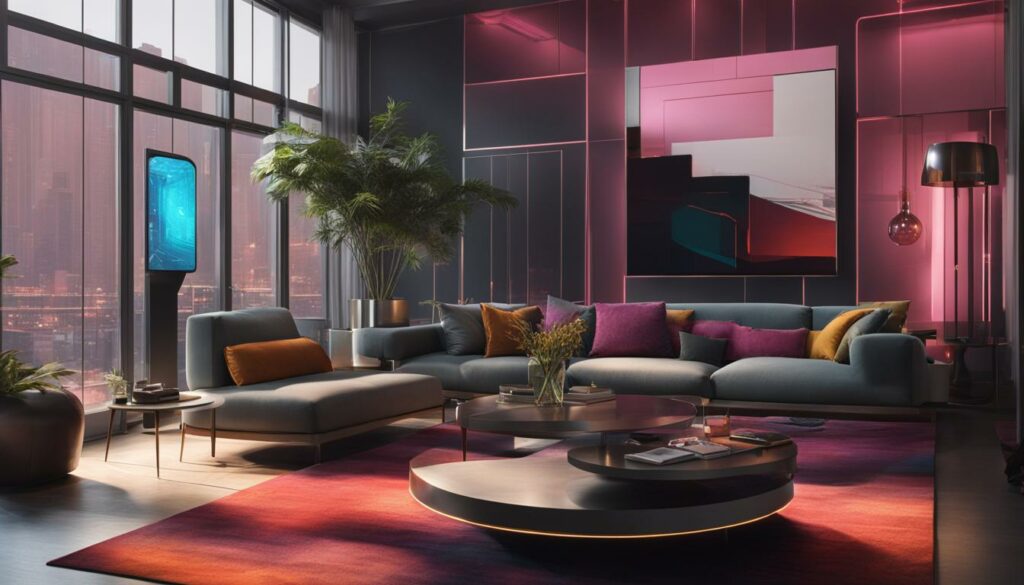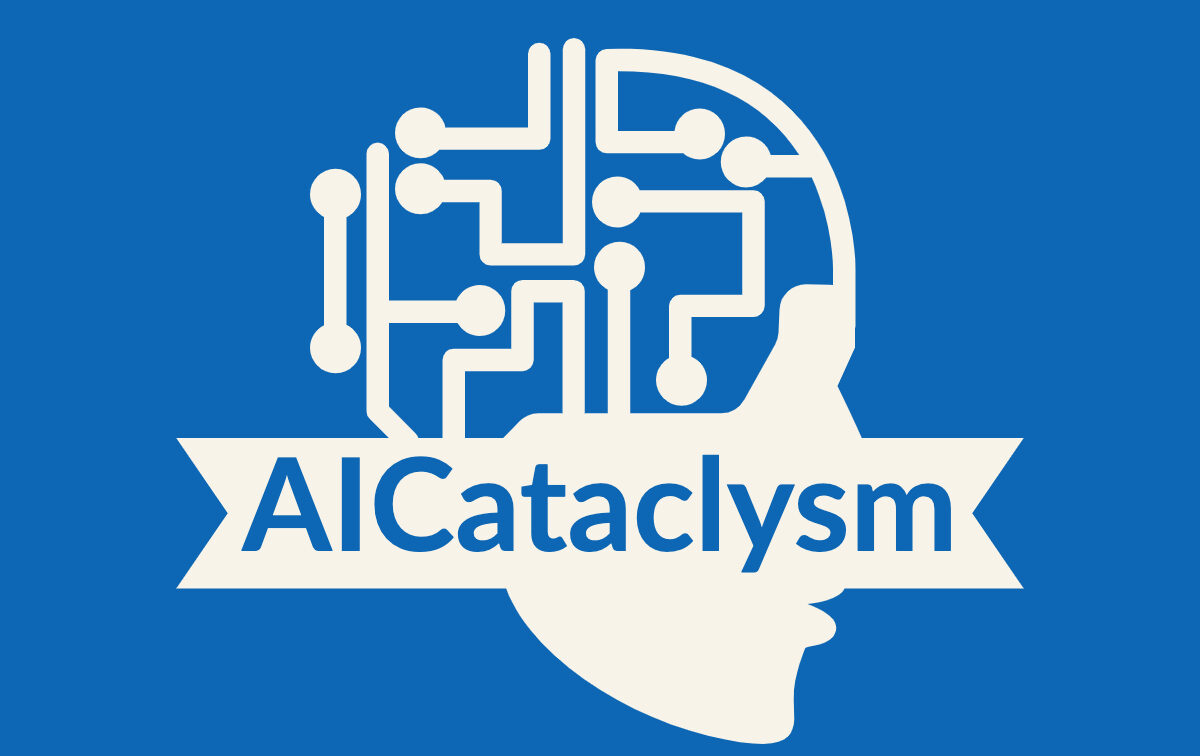The rise of artificial intelligence (AI) technologies has sparked a debate in the interior design industry: Will AI replace human designers? In this article, I will delve into the challenges and distinctions between AI-generated designs and human expertise. We will explore the impact of AI on the industry, the limitations of AI in understanding complex prompts and dimensions, and the importance of human creativity, cultural elements, and a personalized touch in exceptional interior design.
Key Takeaways:
- AI technology has made significant advancements in the interior design field.
- While AI can automate tasks, it falls short in areas that require human creativity and cultural understanding.
- Human designers build strong relationships with clients, incorporating personalization into their designs.
- Creativity is a fundamental aspect of interior design that AI struggles to replicate.
- AI should be seen as a tool that complements human designers, not as a replacement.
AI’s Role in Interior Design
Artificial intelligence (AI) has made remarkable advancements in the field of interior design, revolutionizing the way designers approach their work. With the help of AI technology, designers can now automate tasks that were once time-consuming and tedious, allowing them to focus their energy on more creative aspects of their projects. AI can assist designers in various ways, such as space planning, furniture selection, and color palette recommendations. By analyzing data and trends, AI-powered software can provide valuable insights, making the initial stages of design projects more efficient and data-driven.
However, it’s important to recognize that AI has its limitations in interior design. While it excels in processing vast amounts of information and generating suggestions, it often falls short in areas that require human creativity, intuition, and cultural understanding. AI-generated designs lack the nuanced perspectives and intricate details that human designers bring to the table. Design is not just about arranging furniture and choosing colors; it’s a deeply personal and creative process that involves understanding clients’ needs, preferences, and emotions.
Therefore, while AI can enhance certain aspects of the design process, it cannot fully replace the unique blend of creativity, empathy, and cultural understanding that human designers offer. When it comes to creating exceptional and personalized interior spaces, the human touch remains indispensable. Designers must embrace AI as a valuable tool that complements their skills, rather than viewing it as a threat. By harnessing the benefits of AI and combining it with their own expertise, designers can shape the future of interior design and continue to provide innovative and personalized solutions for their clients.
AI’s Impact on the Design Industry
AI’s advancements in interior design have had a profound impact on the design industry as a whole. It has transformed the way designers work, streamlining processes, automating tasks, and enhancing efficiency. By analyzing large datasets, AI can identify design trends and user behavior, providing designers with valuable insights for their projects. This data-driven approach allows designers to make informed decisions and create designs that meet the needs and preferences of their clients.
Furthermore, AI has the potential to reshape the design landscape by redefining the role of designers. Rather than replacing designers, AI serves as a collaborator, freeing up designers’ time from routine tasks and allowing them to focus on the creative, empathetic, and strategic aspects of their work. The future of interior design lies in the collaboration between human creativity and AI efficiency, where designers leverage AI as a tool to enhance and augment their skills.
The Limitations of AI in Interior Design
While AI has made significant advancements in the field of interior design, it has its limitations when compared to human designers. AI struggles in understanding complex prompts and dimensions, often resulting in distorted proportions and skewed perspectives in its generated designs. The lack of intricate details and the inability to capture adaptability, sensitivity, and creative exploration further highlight the limitations of AI in creating exceptional interior designs. These shortcomings emphasize the irreplaceable role of human designers in the industry.
Unlike AI, human designers possess the innate ability to think critically, creatively, and empathetically. They can understand and incorporate cultural influences and personalization into their designs, creating spaces that resonate with emotions and experiences. Human designers build strong relationships with their clients, allowing for a personalized approach to design that AI cannot replicate. The human connection and personalized touch that designers provide are vital in delivering exceptional and tailored interior designs.
In addition to the creative aspects, AI struggles in the realm of design thinking. Design thinking is a human-centered approach that requires empathy, understanding of user needs, and problem-solving skills. AI’s programming constraints limit its ability to empathize with human experiences and incorporate ethical considerations and cultural sensitivities into designs. Designers play a crucial role in making decisions that resonate with users on an emotional level, an aspect that AI currently cannot replicate.
The Limitations of AI in Interior Design
| AI Limitations | Human Designers’ Expertise |
|---|---|
| Struggles with complex prompts and dimensions | Can understand and incorporate intricate details |
| Lacks adaptability, sensitivity, and creative exploration | Emphasize personalized touch and cultural influences |
| Unable to think critically and empathetically | Design thinking with a human-centered approach |
| Programming constraints limit ethical considerations | Incorporates ethics and cultural sensitivities |
Despite its limitations, AI can still be a valuable tool in the interior design industry. It can automate repetitive tasks, analyze data to provide insights, and streamline processes to increase efficiency. However, it should be seen as a complement to human designers rather than a replacement. The future of interior design lies in a collaborative partnership between designers and AI, where designers harness the benefits of technology while continuing to bring their unique creativity, intuition, and empathy to the table.
The Importance of Human Connection in Interior Design
When it comes to interior design, the human connection is an essential element that cannot be replicated by AI. As designers, our relationships with clients are built on trust, empathy, and understanding. We take the time to listen to their needs, preferences, and aspirations, allowing us to create personalized spaces that truly reflect their unique personalities and lifestyles.
Unlike AI, human designers have the ability to incorporate clients’ stories, cultural influences, and individual histories into their work. We understand that a home is not just a physical structure but a place where memories are made and emotions are felt. By infusing these elements into our designs, we can create spaces that resonate with our clients on a deep, emotional level.
Furthermore, the personalized touch that human designers bring to interior design is invaluable. We have the intuition to understand when a space needs a certain color or texture to create the desired ambiance. We can carefully select furniture, artwork, and accessories that not only complement the space but also enhance the overall experience for the occupants. AI, on the other hand, lacks the ability to replicate this level of thoughtfulness and attention to detail.
| Benefits of Human Connection in Interior Design | AI Limitations in Human Connection |
|---|---|
|
|
As a designer, I believe that the human connection is the heart and soul of interior design. It is what sets us apart from machines. By embracing this connection and harnessing our creativity, empathy, and cultural understanding, we can continue to create exceptional and personalized spaces for our clients.
The Role of Creativity in Interior Design
Creativity is at the core of exceptional interior design, going beyond the mere arrangement of furniture and color selection. As an interior designer, I believe that creativity is what sets us apart and allows us to push boundaries, experiment with new ideas, and redefine industry norms. While AI has made significant advancements in assisting designers with automation and data analysis, its limitations in creativity are apparent.
AI-generated designs often adhere to established patterns and struggle to come up with original ideas. They lack the ability to infuse adaptability, sensitivity, and the exploration of new design concepts that human designers excel in. The intricate details, uniqueness, and personalized touch that human designers bring to their projects cannot be replicated by AI.
In interior design, creativity is not just about aesthetics; it is about understanding the emotions, experiences, and stories of our clients. It is about incorporating their cultural influences and individual histories into our designs. This personalized approach creates spaces that resonate with the clients on a deep level, evoking a sense of connection and belonging. This is where the true power of human creativity lies in interior design.
So, while AI can be a valuable tool in the design process, it cannot replace the innate creative abilities of human designers. As we embrace the future of design with AI, we must remember that it is a collaborator, not a replacement. By harnessing the benefits of AI technology and combining it with our creative expertise, we can continue to create exceptional, personalized, and meaningful interior designs that leave a lasting impact on our clients.
A Comparison of AI and Human Designers
| AI in Interior Design | Human Designers |
|---|---|
| Automates routine tasks | Brings creativity and originality |
| Provides data-driven insights | Understands clients’ emotions and experiences |
| Lacks adaptability and sensitivity | Infuses cultural influences and personalization |
| Struggles with creativity and exploration | Pushes boundaries and redefines industry norms |
AI as a Tool in Interior Design
In the world of interior design, AI is increasingly being recognized as a valuable tool that complements the skills of human designers. Rather than viewing AI as a threat, designers can leverage its capabilities to enhance their work and streamline the design process. AI’s efficiency in automating tedious tasks can free up designers’ time, allowing them to focus on more creative aspects of their work.
One of the key advantages of using AI as a tool in interior design is its ability to analyze large datasets and provide valuable insights. AI-powered software can process vast amounts of information on design trends, user behavior, and preferences, helping designers make more informed decisions. With AI’s data-driven insights, designers can create spaces that resonate with their clients’ needs and preferences.
“AI can automate routine tasks and provide data-driven insights, but it cannot replicate the unique blend of creativity, intuition, empathy, and cultural understanding that human designers bring to the table.” –Interior Design Expert
Moreover, AI can assist designers in generating design options and exploring different possibilities. By automating tasks such as space planning, furniture selection, and color palette recommendations, AI can speed up the initial stages of the design process. This allows designers to iterate and experiment with ideas more efficiently, leading to more innovative and personalized design solutions.
Table: AI vs. Human Designers
| AI | Human Designers | |
|---|---|---|
| Creativity | Limited in generating original ideas | Push creative boundaries and think outside the box |
| Cultural Understanding | Struggles to incorporate cultural influences | Incorporate cultural elements and personalized touch into designs |
| Emotional Connection | Lacks the ability to create designs that resonate on an emotional level | Build strong relationships with clients and create personalized spaces |
In conclusion, AI is not a replacement for human designers but a valuable tool that can enhance their work. By leveraging AI’s efficiency in automating tasks and its ability to provide data-driven insights, designers can streamline their workflow and make more informed design decisions. The future of interior design lies in a collaborative partnership between AI and human designers, where technology complements the creative expertise and cultural understanding that only humans can bring to the table.
The Future of Interior Design with AI
As the interior design industry continues to evolve, the role of artificial intelligence (AI) is becoming increasingly prominent. AI has the potential to revolutionize the way we approach design, from automation to data-driven insights. With its ability to analyze large datasets and automate routine tasks, AI is transforming the design landscape. However, it’s important to understand that AI will never replace the unique blend of human creativity, intuition, and empathy that designers bring to the table.
AI’s impact on the design industry is undeniable. It has the power to streamline processes, increase efficiency, and provide valuable insights. By automating tasks such as space planning and furniture selection, AI can save designers time and allow them to focus on more creative aspects of their work. Additionally, AI’s ability to analyze data can provide designers with insights on design trends and user behavior, enabling them to make more informed decisions.
While AI is a powerful tool in the design process, it is not a substitute for human designers. Design is a deeply personal and creative process that requires empathy, cultural understanding, and the ability to connect with clients on an emotional level. AI lacks the ability to replicate these human connections and the personalized touch that designers provide. Designers are essential in translating clients’ needs, preferences, and lifestyles into exceptional and personalized interior designs.
In summary, the future of interior design lies in a collaborative partnership between designers and AI. AI can enhance efficiency, automate tasks, and provide valuable insights, but it will never replace the unique qualities that human designers bring to the table. By embracing AI as a tool and adapting to the changing landscape, designers can harness the benefits of technology while maintaining their irreplaceable role in creating exceptional and personalized interior designs.
Table: AI’s Impact on the Design Industry
| Benefits of AI in Interior Design | Limitations of AI in Design Thinking |
|---|---|
| Automation of routine tasks | Lack of empathy with human experiences |
| Data-driven insights | Inability to incorporate ethical considerations and cultural sensitivities |
| Increased efficiency and productivity | Programming constraints |
The Benefits of AI in Interior Design
The advancement of artificial intelligence (AI) technology has brought numerous benefits to the field of interior design. AI’s automation capabilities have revolutionized design tasks, making them more efficient and freeing up designers’ time to focus on the creative aspects of their work. By automating routine tasks such as space planning and furniture selection, AI streamlines the design process, allowing designers to deliver projects more quickly without compromising on quality.
Moreover, AI’s ability to analyze large datasets provides designers with valuable insights and trends in the industry. By analyzing data on user behavior, AI can assist in making informed decisions about design choices and preferences. This data-driven approach helps designers create spaces that align with the needs and desires of their clients, enhancing customer satisfaction and delivering exceptional results.
AI in interior design has transformed the way we work, providing us with new tools and capabilities that improve efficiency and enhance the design process. It allows us to focus on the creative aspects of our work while AI takes care of the repetitive tasks. The combination of human creativity and AI technology opens up new possibilities for innovative and personalized design solutions.
Additionally, AI’s ability to learn and adapt over time enables designers to continually improve their work. By analyzing the outcomes and feedback from previous projects, AI can refine its recommendations and design suggestions, leading to more accurate and tailored solutions. This iterative process allows designers to deliver better results with each new project, ensuring constant growth and improvement.
| Benefits of AI in Interior Design | Examples |
|---|---|
| Automation of routine tasks | Space planning, furniture selection, color palette recommendations |
| Data-driven insights | Analyzing user behavior, trends in the industry |
| Improved efficiency | Streamlining the design process, saving time |
| Continuous improvement | Learning from past projects, refining recommendations |

The Future of Interior Design with AI
As AI continues to advance, its role in the interior design industry will only grow. AI will become an invaluable tool for designers, working alongside them to enhance the design process and deliver exceptional results. The combination of human creativity and AI’s computational power will enable designers to push the boundaries of design, create personalized spaces, and provide innovative solutions that improve the quality of life for individuals and communities.
With AI as a collaborator, designers can embrace the future of design, harnessing the benefits of technology while maintaining the unique qualities that make them indispensable in the creative process. By adapting and staying at the forefront of AI advancements, designers can shape the industry and continue to create remarkable interior designs that inspire and delight.
The Limitations of AI in Design Thinking
While artificial intelligence (AI) has made remarkable advancements in various fields, including interior design, it still has limitations when it comes to design thinking. One of the key limitations is AI’s inability to empathize with human experiences. Design thinking requires an understanding of the emotions, needs, and motivations of users, which AI struggles to replicate. Human designers, on the other hand, possess the unique ability to connect with clients on a personal level, allowing them to create designs that resonate with their emotions and experiences.
Another constraint of AI in design thinking is its programming limitations. AI operates based on algorithms and data analysis, which can restrict its ability to incorporate ethical considerations, cultural sensitivities, and complex decision-making into designs. Designers play a crucial role in making thoughtful decisions that go beyond data analysis, taking into account the broader implications and impact of their designs on society and individuals.
In conclusion, while AI has its benefits in automating tasks and providing insights, it is limited in design thinking. The human-centered nature of design requires empathy, intuition, and the ability to tackle complex problems creatively. Although AI can support designers in certain aspects, the irreplaceable role of human designers will remain significant in understanding human experiences, incorporating ethical considerations, and making empathetic design decisions.
The Limitations of AI in Design Thinking
| Limitations of AI in Design Thinking | Implications |
|---|---|
| AI’s inability to empathize with human experiences | Designs may lack emotional resonance and fail to meet users’ needs on a deeper level. |
| AI’s programming constraints | Designs may overlook ethical considerations, cultural sensitivities, and complex decision-making. |
AI’s Impact on the Design Industry
Artificial intelligence (AI) is revolutionizing the design industry, transforming traditional processes and shaping the future of interior design. With its ability to automate tasks, provide valuable insights, and streamline workflows, AI is making a significant impact on how designers approach their work.
AI’s role in transforming design processes is evident in its efficiency and data-driven capabilities. By automating tedious tasks such as space planning and furniture selection, AI allows designers to save time and increase productivity. Additionally, AI’s ability to analyze large datasets provides designers with valuable insights on design trends and user behavior, enabling them to make informed decisions.
“AI is revolutionizing the design industry by streamlining processes, automating tasks, and providing valuable insights.”
However, despite its advantages, AI cannot replace the unique blend of creativity, intuition, empathy, and cultural understanding that human designers bring to the table. While AI-generated designs may be efficient and data-informed, they often lack the intricate details, adaptability, and personalized touch that human designers excel in.
In the ever-evolving design landscape, designers need to embrace AI as a tool and adapt to the changing industry. By leveraging AI’s capabilities in automation and data analysis, designers can enhance their creative process and create more innovative and personalized design solutions. The future of interior design lies in a collaborative partnership between designers and AI, where AI complements human creativity and expertise to deliver exceptional spaces.
| AI’s Impact on the Design Industry | AI and the Future of Interior Design | AI’s Role in Transforming Design Processes |
|---|---|---|
| Automation of tedious tasks | Incorporating AI as a tool in the design process | Streamlining workflows and increasing efficiency |
| Data-driven insights on design trends | Adapting to the changing industry landscape | Enhancing creativity through AI’s capabilities |
| A balance between AI efficiency and human creativity | Embracing collaboration between designers and AI | Delivering exceptional and personalized design solutions |
Embracing the Future of Design with AI
As a designer, I believe in embracing the future of design with AI and seeing it as a collaborator rather than a threat. AI has the potential to revolutionize the design process, allowing us to automate tasks, gather valuable insights, and streamline workflows. However, it’s important to recognize that AI cannot fully replace the unique blend of creativity, intuition, empathy, and cultural understanding that human designers bring to the table.
Adapting to AI is crucial for designers to stay relevant in this rapidly changing industry. By leveraging AI as a tool, we can enhance our efficiency and productivity, freeing up valuable time to focus on the more creative aspects of our work. AI can handle data analysis, provide suggestions, and assist with routine tasks, while we continue to infuse our designs with the personal touch and emotional resonance that only humans can deliver.
Collaboration between designers and AI is the key to success in the future of design. We can harness the benefits of AI technology while maintaining our unique expertise and understanding of human needs and desires. By working in tandem with AI, we can create innovative and personalized interior designs that inspire and delight our clients.
FAQ
Will AI replace human interior designers?
No, AI will not replace human interior designers. While AI technology has made significant advancements in the field, it has limitations in areas that require human creativity, intuition, and cultural understanding.
What is AI’s role in interior design?
AI can assist interior designers by automating tasks such as space planning, furniture selection, and color palette recommendations. It can also analyze data and trends to provide valuable insights for more efficient and data-driven design projects.
What are the limitations of AI in interior design?
AI struggles to replicate human creativity, understand complex prompts and dimensions, and incorporate cultural influences and personalization into designs. AI-generated designs often lack intricate details and the adaptability and sensitivity that human designers excel in.
Why is human connection important in interior design?
Human designers build strong relationships with their clients, allowing for a personalized approach that incorporates clients’ stories, cultural influences, and individual histories into their work. AI lacks the ability to replicate these human connections and provide the personalized touch that human designers provide.
What role does creativity play in interior design?
Creativity is essential in interior design as it goes beyond arranging furniture and choosing colors. Human designers push creative boundaries, experiment with new ideas, and bring originality to their work. AI-generated designs often adhere to established patterns and struggle to come up with innovative ideas.
How can AI be used as a tool in interior design?
AI can automate tedious tasks, provide insights based on data analysis, and streamline processes in the design workflow. By utilizing AI’s efficiency in these areas, designers can focus more on the creative aspects of their work.
What does the future of interior design with AI look like?
The future of interior design is likely to be a fusion of human creativity and AI efficiency. AI will continue to shape the design landscape, but human designers will remain at the heart of the creative process, working in collaboration with AI technology.
What are the benefits of AI in interior design?
AI can automate tasks such as space planning and furniture selection, saving designers time and increasing efficiency. It can also analyze large datasets to provide valuable insights on design trends and user behavior, leading to more informed decision-making.
What are the limitations of AI in design thinking?
AI’s programming constraints limit its ability to empathize with human experiences and incorporate ethical considerations and cultural sensitivities into designs. Designers play a crucial role in making decisions that resonate with users on an emotional level, which AI cannot currently replicate.
How is AI impacting the design industry?
AI is revolutionizing the design industry by streamlining processes, automating tasks, and providing valuable insights. While it may not replace human designers, AI will continue to reshape the industry and redefine the role of designers.
How can designers embrace the future of design with AI?
Designers should see AI as a collaborator rather than a threat. By embracing AI as a tool and adapting to the changing landscape, designers can harness the benefits of technology while maintaining their irreplaceable role in creating exceptional and personalized interior designs.






